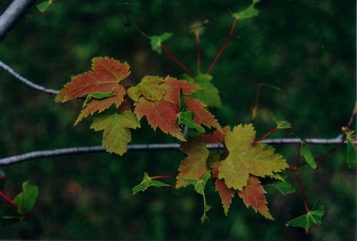Red maple

It is a temperate plant. A native of north America. It requires deep fertile soils. It needs a sheltered position and is best in light shade. It is frost resistant but is damaged by drought. It can grow in acid soils. Often it grows in swamps and on moist soils. It suits hardiness zones 4-8. Arboretum Tasmania.
Also known as:
Canadian Maple, Curled Maple, Scarlet maple, Swamp maple
Edible Portion
- Sap, Seeds, Leaves, Bark
Where does Red maple grow?
Found in: Australia, Britain, Canada, Europe, North America, Russia, Tasmania, Turkey, United States
Notes: There are about 120-150 Acer species.
Growing Red maple
Cultivation: It is grown from ripened seed.
Edible Uses: The sap of the tree is used as a source of sugar. The inner bark can be cooked, dried, ground into flour then used to thicken soups. The leaves of self sown seedlings can be eaten fresh. The seeds with the wings removed can be boiled and eaten. The sprouted seeds are eaten raw.
Production: Trees live for 100 years.
Nutrition Info
per 100g edible portion| Edible Part | Energy (kcal) | Protein (g) | Iron (mg) | Vitamin A (ug) | Vitamin c (mg) | Zinc (mg) | % Water |
|---|---|---|---|---|---|---|---|
| Sap | - | - | - | - | - | - | |
| Seeds | - | - | - | - | - | - | |
| Leaves | - | - | - | - | - | - | |
| Bark | - | - | - | - | - | - |
Red maple Photos

References
Beckstrom-Sternberg, Stephen M., and James A. Duke. "The Foodplant Database." http://probe.nalusda.gov:8300/cgi-bin/browse/foodplantdb.(ACEDB version 4.0 - data version July 1994)
Bircher, A. G. & Bircher, W. H., 2000, Encyclopedia of Fruit Trees and Edible Flowering Plants in Egypt and the Subtropics. AUC Press. p 6
Bodkin, F., 1991, Encyclopedia Botanica. Cornstalk publishing, p 43
Brickell, C. (Ed.), 1999, The Royal Horticultural Society A-Z Encyclopedia of Garden Plants. Convent Garden Books. p 68
Coombes, A.J., 2000, Trees. Dorling Kindersley Handbooks. p 100
Cundall, P., (ed.), 2004, Gardening Australia: flora: the gardener's bible. ABC Books. p 88
Duke, J.A., 1992, Handbook of Edible Weeds. CRC Press. p 16
Elias, T.S. & Dykeman P.A., 1990, Edible Wild Plants. A North American Field guide. Sterling, New York p 257
Etherington, K., & Imwold, D., (Eds), 2001, Botanica's Trees & Shrubs. The illustrated A-Z of over 8500 trees and shrubs. Random House, Australia. p 69
Facciola, S., 1998, Cornucopia 2: a Source Book of Edible Plants. Kampong Publications. p 1
Farrar, J.L., 1995, Trees of the Northern United States and Canada. Iowa State University press/Ames p 140
Grandtner, M. M., 2008, World Dictionary of Trees. Wood and Forest Science Department. Laval University, Quebec, Qc Canada. (Internet database http://www.WDT.QC.ca)
Harris, E & J., 1983, Field Guide to the Trees and Shrubs of Britain. Reader's Digest. p 132
Harter, J.(Ed.), 1988, Plants. 2400 copyright free illustrations. Dover p 3.2
Hedrick, U.P., 1919, (Ed.), Sturtevant's edible plants of the world. p 22
Kermath, B. M., et al, 2014, Food Plants in the Americas: A survey of the domesticated, cultivated and wild plants used for Human food in North, Central and South America and the Caribbean. On line draft. p 10
Joyce, D., 1998, The Garden Plant Selector. Ryland, Peters and Small. p 106
Little, E.L., 1980, National Audubon Society Field Guide to North American Trees. Alfred A. Knopf. p 577
Lord, E.E., & Willis, J.H., 1999, Shrubs and Trees for Australian gardens. Lothian. p 45
Lyle, S., 2006, Discovering fruit and nuts. Land Links. p 46
MacKinnon, A., et al, 2009, Edible & Medicinal Plants of Canada. Lone Pine. p 66
Plants for a Future database, The Field, Penpol, Lostwithiel, Cornwall, PL22 0NG, UK. http://www.scs.leeds.ac.uk/pfaf/
Schuler, S., (Ed.), 1977, Simon & Schuster's Guide to Trees. Simon & Schuster. No. 78
Sp. pl. 2:1055. 1753
Young, J., (Ed.), 2001, Botanica's Pocket Trees and Shrubs. Random House. p 63